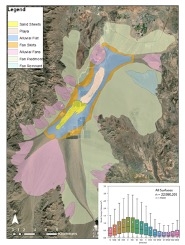Geomorphic controls on shrub canopy volume and spacing of creosote bush in northern Mojave Desert, USA

James (Jake) Gearon, Michael H. Young
Landscape Ecology, 2020, https://doi.org/10.1007/s10980-020-01149-8
Study Summary
The dynamics of plant-water-soil interactions are complex and rarely studied on the basin scale. We use a novel dataset, collected from an earlier project, of the locations and canopy volumes of nearly 23 million creosote bushes (Larrea tridentata), which are located in a relatively unperturbed desert basin in Eldorado Valley, near Boulder City, Nevada. This dataset was generated via remote sensing (hyperspectral imagery and LiDAR) and then checked using ground-truthed measurements. Here, we aim to determine the primary abiotic (e.g., geologic) factor(s) that control creosote bush growth by relating canopy volume and spatial distribution to both aspect (surface direction) and underlying geomorphology. Statistical analyses show that aspect and geomorphic surface age influence creosote bush canopy volume and spacing between shrubs for all five geomorphic surfaces studied. The highest median canopy volumes (0.758 m3) were found on east-facing surfaces and were almost 5 times larger than the lowest median volumes found on WNW-facing surfaces (0.152 m3). Variability in shrub volume was also higher on east-facing than west-facing surfaces. Spacings between shrubs located on alluvial flat and fan skirt surfaces (2.418 and 2.333 m, respectively) were larger than those on alluvial fan, fan piedmont, and fan remnant surfaces (1.776, 1.837, and 1.892 m, respectively). We found that 1) shrubs grow (5 times) larger on east-facing surfaces where they efficiently photosynthesize in the pre-noon hours; 2) shrubs grow larger on younger geomorphic surfaces because the soil horizon development is weaker than the water-limiting, clay-rich horizons in older geomorphic units; 3) shrub spacing is largest on younger surfaces but smallest on “intermediate” surfaces (e.g., alluvial fans), possibly because of transition between competitive regimes; and 4) creosote bushes are biotically competitive on younger surfaces, especially east-facing surfaces. As soil development progresses, shrubs become less competitive with each other because the clay-rich soil horizon development restricts water percolation to the roots. On the oldest surfaces, plants are small and far apart, indicating little to no competition.
Why is this research important and why do the results matter?
- Ground-based investigations of basin-scale problems are expensive and time-consuming. Remote sensing allows us to conduct investigations into soil-plant-water interactions in a way that was previously untenable.
- We demonstrate for the first time the E–W dependence on shrub canopy volumes, which is supported by small-scale studies of creosote bush adaptive traits.
- We provide evidence for a complex interplay between soil development, plant competition, and aspect.